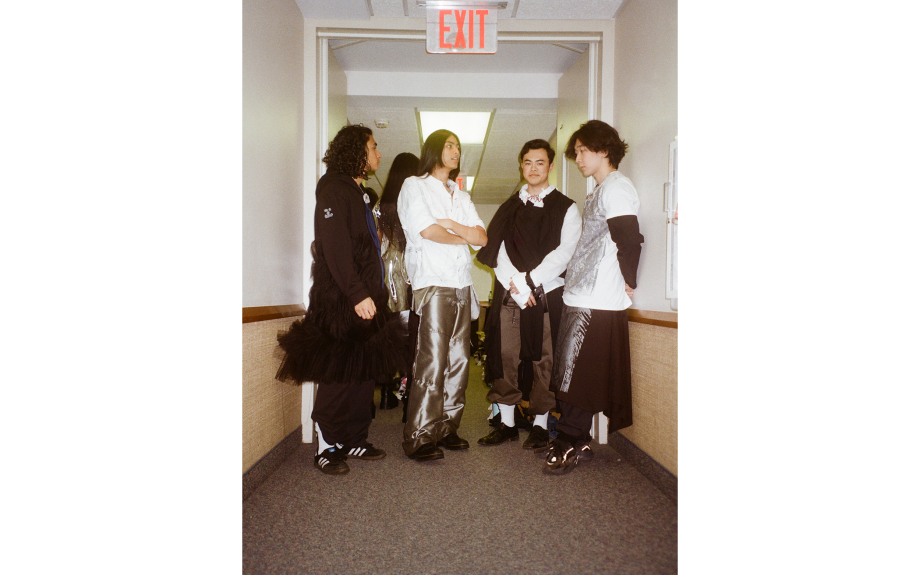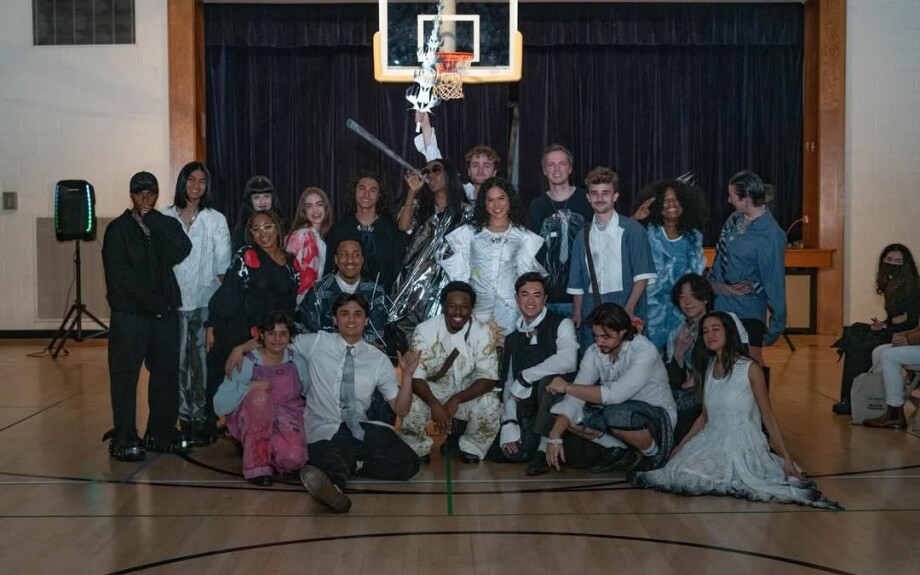The church building was in the heart of New York City, just steps away from the Lincoln Center. What was about to happen there was practically unheard of, but Pono Skousen was determined to make it a success. For months, the aspiring fashion designer and Latter-day Saint had spent countless hours orchestrating every detail of his first fashion show down to the final stitches on his 20 unique looks. He’d been designing, sewing, and praying that it would all go seamlessly.
Organizing an entire fashion show is not for the faint of heart—Pono created each look, recruited models, circulated advertisements, collaborated with musicians, and more on top of an already jam-packed schedule as a student at the prestigious Parsons School of Design. “There were so many opportunities to say, ‘Yeah this is kind of too much,’” Pono recalls.
But Pono had a vision: create an experience that presents faith and fashion in a way that’s accessible for both Latter-day Saints and the fashion community. “I wanted to keep everyone engaged, and I wanted them to see that fashion is all about the feeling,” Pono says.
After many long days and late nights in the studio, Pono’s vision came to life. Rows of hard metal folding chairs lined the runway in his church’s cultural hall, which was packed with Latter-day Saints and curious New Yorkers. As the lights dimmed and the music played, the crowd hushed, waiting to see Pono’s faith-inspired looks. From edgy jeans to modern dresses, the looks that Pono created blend his love fashion and the gospel.
Pono’s journey to that long-awaited fashion show started long before the crowd gathered in the cultural hall. It included postponing his dreams in fashion to serve a mission, working in the wardrobe department on the Book of Mormon Videos project, and years hard work and sacrifice. So as onlookers watched each look in Pono’s collection walk the runway in New York City, they didn’t just take in an impressive display—they saw Pono’s life and faith in every stich and pattern. And they would likely never have guessed that if it wasn’t for a handful of Relief Society sisters, Pono may not have been a designer presenting his collection before them at all.
First, Pillowcases
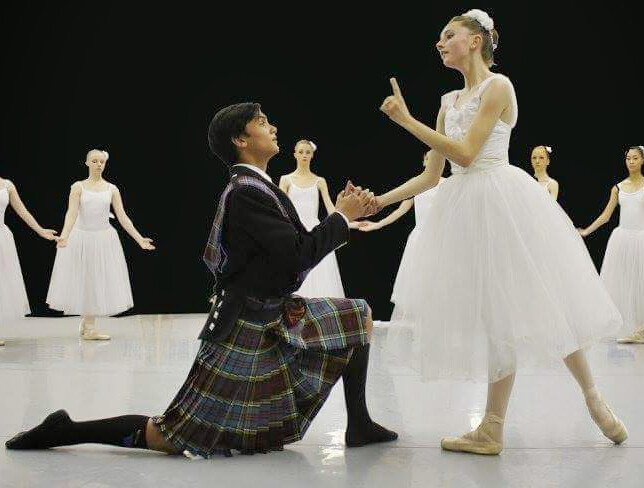
While Pono may spend long hours in the sewing studio as a fashion design student, he spent his childhood in a completely different type of studio: When he was just five years old, he started ballet, and by the time he was 15, he danced his way into the Miami City Ballet’s pre-professional program. He had only been with the company for two years when his father, an officer in the US Air Force, received reassignment to Beale, California, a rural farming town. Pono was faced with a choice: stay in glitzy Miami and dance toward a potential professional career, or move across the country with his parents.
Choosing to be with his family, Pono put his ballet shoes on the shelf and found himself with a lot of time on his hands in California. So he started going to Relief Society activities with his mom, Sandi, where he learned to sew for the first time. At the beginning, he started off with easy projects, like pillowcases, but he quickly wanted to try more complex designs.
Since Sandi wasn’t an experienced sewer, she asked several Relief Society sisters to teach Pono how to sew. They came on a regular basis, bringing projects that they were working on and teaching Pono the basics of sewing, from threading the machine to following patterns, and eventually manipulating those patterns to create the designs Pono was imagining. “I attribute my start [in fashion design] to the Relief Society,” Pono says.

With the help of what Pono calls his “Relief Society buddies,” the teenager started working on larger clothing projects than just pillowcases—just for fun, he even sewed prom dresses for his high school dates!
In high school, Pono started looking into fashion schools, including the Parsons School of Design, which boasts grads like fashion designer Marc Jacobs and contemporary artist Ai Weiwei. So when the opportunity came to present his portfolio to a Parsons representative at a recruitment open house in San Francisco, Pono jumped on it.
“They had really positive things to say about Pono’s portfolio,” Sandi says, “which was surprising because all of these other students who came with their portfolios had gone to art schools. But because we had moved around so much, [Pono] never had the chance to do any of that. So he’s really self-taught.”
The open house left Pono feeling motivated to work toward attending Parsons School of Design, which is ranked as one of the top schools for art and design in the US and in the world. After applying, he was thrilled to be offered an interview. So in the spring of 2019, 18-year-old Pono polished up his portfolio and traveled to the Big Apple on his own. But he left the interview feeling unsure about whether he had made an impression. “My work was still very basic in terms of concept and design,” he recalls. It was after the interview, though, that Pono had an unexpected experience that would shake up his plans.
“I left the university, and I met two elders in Union Square,” Pono says, “I said, ‘Whoa, what are you guys doing here?’ I talked to them and actually ended up shadowing them for the rest of that day.”
Ever since Pono was a kid, he had wanted to serve a mission, but he was hoping to go to school in New York first. After making contacts in the subway and knocking on doors in the Bronx with the missionaries, however, he knew his plans needed to change. “After that experience I thought, ‘I need to serve my mission—now. I can’t wait to see what happens. It’s now or never.’”
I thought, ‘I need to serve my mission—now. I can’t wait to see what happens. It’s now or never.’
Pono was excited to learn that he had been accepted to Parsons and was even offered a scholarship, but since his coincidental experience with the elders, he knew—without a doubt—that prioritizing a mission was the right choice. So even though the school wouldn’t hold his place for more than a year, he turned Parsons down, hoping that in the future he would get in again. Pono didn’t know it then, but that sacrifice wouldn’t just shape his testimony—it would impact his success in fashion.
A Testimony in the Wardrobe Department
When Pono began preparing for a mission, he started saving up in order to support himself for the two years he’d be away from home. For many Latter-day Saint youth, that means working retail or landscaping jobs, but Pono traveled to Kauai, Hawaii, to work in the wardrobe department on the Book of Mormon Videos project. “I was planning on bagging groceries at a supermarket,” Pono recalls, but after hearing about this opportunity through his aunt, who lives on the island, he submitted his portfolio to the director of costume, Jackie. “She called me and said, ‘You’re in. We’d love to have you,’” Pono recalls.
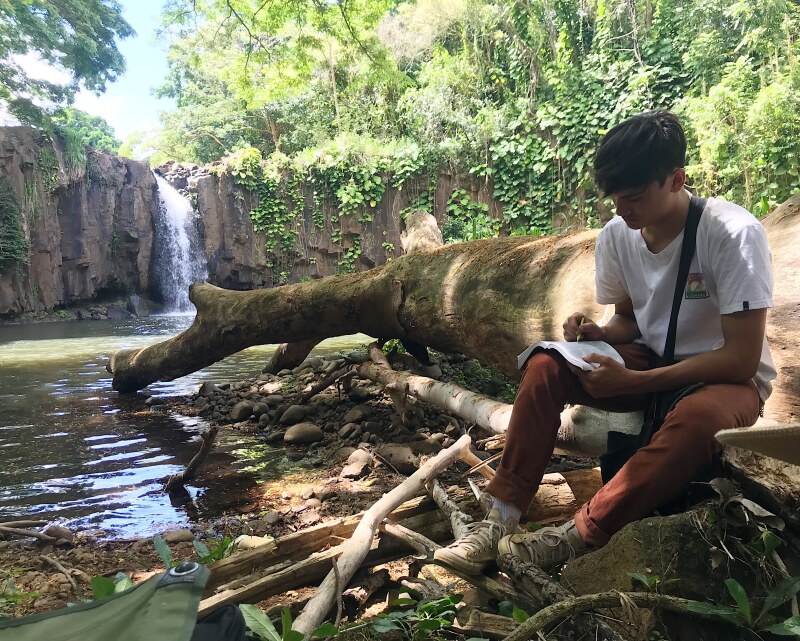
Working on the project turned out to be not just a perfect place for gaining fashion design experience, but also for gaining a deep testimony of the Book of Mormon. Pono had grown up going to church regularly and he studied the scriptures in seminary and Sunday School. But he was surprised when some of the Book of Mormon scenes unfolding in front of him on set were unfamiliar. So while he was in Hawaii working on the Book of Mormon Videos project, Pono decided to read the book from start to finish for the first time. “Reading the Book of Mormon on the set, literally watching it happen in front of me, and seeing the characters come alive, I think was the perfect place for me to really gain a testimony that these events actually happened,” Pono says. “These were, in fact, real people that were called of God. And we have their stories.”

Armed with a newfound testimony of the Book of Mormon and a conviction that it needed to be shared, Pono departed to the Brazil Cuaibá Mission in October 2019. But due to the COVID-19 pandemic, Pono was sent home in March 2020 and was released. While he was awaiting reassignment during the next four months, he started sewing and adding pieces to his portfolio. Between the costumes he had worked on for the Book of Mormon Videos project and his new work, Pono had a completely different portfolio to submit to Parsons the second time.
After submitting his portfolio once more, Pono was reassigned to the Salt Lake City South Mission, where he served from June 2020 to March 2021. While Pono was serving in Salt Lake, he was invited to interview with Parsons for the second time. With permission from his mission president, Pono interviewed via Zoom and was accepted again—this time, with an even larger scholarship.
The difference? The reviewers noticed a significant improvement from Pono’s first portfolio to the second, and they were especially intrigued by the unfamiliar, creative costumes that Pono had included from his work on the Book of Mormon Videos project. During the interview, Pono remembers, “I had to explain, ‘Oh, this is the Book of Mormon. It’s actually about people in the ancient Americas, so we were portraying [them] in film and costume.’” He adds that being able to share the premise of the Book of Mormon with the Parsons representatives was one of his greatest mission experiences.
In March 2021, Pono returned to Brazil to finish his mission. While there, Pono realized how important the Book of Mormon Videos were to the worldwide church. “[In Brazil] a lot of people couldn’t read,” Pono says. “Having these videos for them to take part of was another testament to me of the gathering of Israel, and of God really getting in the details now and making sure all His children have access to the book.”
Faithful Fashion in New York
Soon after returning home from his mission, Pono, now 20 years old, moved to New York City to start school—and the transition was jarring. He’d gone from wearing the same outfit every day for two years to attending a top-tier fashion design school in one of the biggest cities in the world. “When I got off my mission, I didn’t really have any style,” Pono says. “So coming to New York right after to study fashion was intimidating. I was very overwhelmed, like, ‘Oh my gosh, skinny jeans aren’t cool anymore? What is happening?’”
It was through my weakness that I found new ways of creating, and that became a strength to me.
He didn’t just feel behind his peers in personal style but also in terms of technical skills, like sketching and garment construction. So during his first year, Pono worked hard to catch up. “Where I wasn’t the best sketcher, I started collaging instead. And where I wasn’t the most knowledgeable about fabric samples, I would go to the fabric store and sample all the fabrics,” Pono remembers. “I like the scripture in Ether 12 that talks about turning your weaknesses into strengths, because I think it was through my weakness that I found new ways of creating, and that became a strength to me. It was so different [from] what everyone else was doing.”
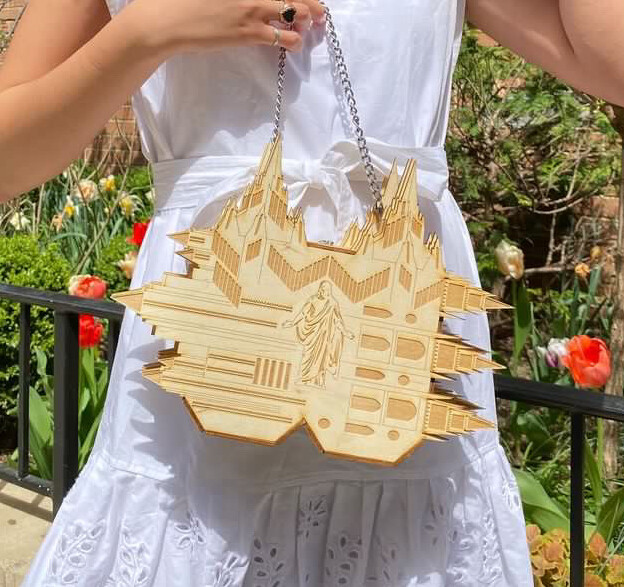
For one of his school assignments, Pono was required to create an object that symbolized his relationship to a certain community. Drawing from his experiences in the Church, he created a wood scripture case using a laser-cutting machine. Pono incorporated the outlines of temples and the New York City skyline into the shape of the wood, blending his love for the gospel, city, and design into one. His teacher, Aviva Maya Shulem, was impressed with the project. “Just by looking at [the bag], you get immediately what exactly the project is about,” she says. “This is an example of how he manifested his faith within that particular project.”
This wasn’t the first or last time that Pono would incorporate faith into his designs. In fact, the title of the portfolio he’s currently working on is called “Faith. Fashion.” Faith and fashion may seem like contradictory ideas—fashion can be considered trendy and cutting edge, while having faith in God isn’t always popular. But for Pono, fashion has an entirely different meaning. “Fashion is an outlet to express my identity—who I am, where I come from,” he says. “[After] being on the mission, a lot of my art became very reflective of my testimony. And that's where I got a lot of inspiration.”

Pono recalls a design that opened up conversations about his faith with his classmates. The design was inspired by the classic white shirt and tie that young deacons often wear to church. “When I think of deacons, I think of these huge white button-ups and funky ties,” Pono says. “I really wanted to capture the beauty of being a deacon and being in a stage of awkwardness but trying to fill the role they have.” The abstract design incorporated several collars and ties, transforming the traditional look into a flowing, moving design.
When Pono presented the design to his class, he explained that he also wanted to pay homage to the white collared shirt and tie that he had worn every day for two years as a missionary. “Immediately after, people asked, ‘Whoa, why did you live like that? What were you doing? Why did you dress like that?’ I was able to have a lot of dialogue about my mission experiences and the people I met,” Pono says.
Faith on the Runway
Pono is now a sophomore at Parsons, where he’s been working on a streetwear collection called “Skating and Religion,” which represents being in the world but not of the world. To Pono, that means “being knowledgeable about what is happening around you, but still having a firm belief of who you truly are.” That’s why he chose to combine a young, current skater style with religious themes in his designs, showing that it’s possible to be in the world and stay true to your faith.
After experimenting with the construction, fabrics, and draping techniques of his looks, Pono knew he wanted to present his entire collection in a fashion show—and what better place to hold it, he thought, than his own ward building? Pono’s Bishop, Blake Carter, remembers Pono’s hesitancy when he requested permission to hold the fashion show at the church. “He came in [my office] somewhat tentatively, saying, ‘You may not want to do this, but here is my idea,’” Bishop Carter says. “[But] I was eager to support him.”
When Pono decides to focus on a particular project, he is going 120 percent—not 100 percent, but 120 percent!
Presenting an entire collection is something that senior design students, let alone sophomores, rarely try to pull off—the task is monumental. But Pono is no stranger to hard work and was determined to achieve his goals—something that doesn’t surprise his teacher, Aviva Maya Shulem. “When [Pono] decides to focus on a particular project,” Aviva Shulem says, “he is going 120 percent—not 100 percent, but 120 percent! And that’s what I love about Pono. He is a really, really hard worker, he is super talented, [he is] very passionate, and he doesn’t give up until he reaches his goal.”
And so Pono got to work creating flyers, organizing 20 looks, choosing models, finding live musicians, creating the lighting concept, and managing every detail of the production down to the very last stitch.
When Bishop Carter showed up to the event on May 4, 2023, he was excited to see how many people, both Latter-day Saints and other community members, were walking through the front door and into the cultural hall. “I was super excited to open up our building doors to New York and show them [that] we like fashion just like anybody else. And it would be done with the same fashion vibe you would expect from any fashion show,” he says.
As Bishop Carter has gotten to know Pono over the past two years, he’s noticed something special about him: “The gospel is in Pono’s soul,” he says. Because of that, Pono’s fashion reflects his faith. “[Pono] wants to be true to himself and fulfill his desire to create fashion, and at the same time be true to his testimony and desire to follow Jesus Christ. The way he delivered his fashion show accomplished just that.”
Putting on an entire fashion show was a spectacular achievement for Pono, but it was especially meaningful because of the people who came to support him. “I was really taken aback by the amount of people that came,” Pono says. “We had originally set [up] one row of chairs on each side of the gym, … but then when people arrived, we had to set up three more rows on each side.” Pono was even more surprised to see that a lot of his peers from school were mixed in with the many Latter-day Saints from his stake.
Pono’s faith-filled designs and bright, genuine personality have opened up conversations about faith with people from all walks of life. “I think I've been able to change a lot of people's minds about religion and God, especially Christ,” Pono says. “A lot of my friends now very much respect [my faith], and they also admire how it's portrayed in my work. …
“We’re each given ways to reach people … I know the Lord wants us to explore what we are given and not really focus on what we don’t have but start with what we do have. And just go for it—love the gospel, live the gospel. When we combine that with these talents and things that the Lord has given us, I think that’s when miracles really happen.”
▶ You may also like: An NYC fashion photographer’s path to true love and the Church



